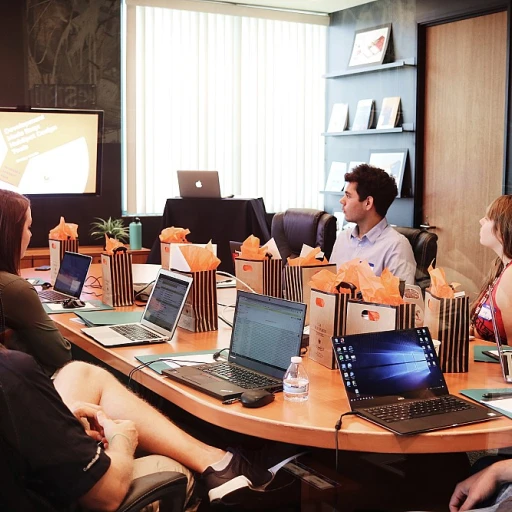
Understanding Scenario Analysis
Unveiling the Potential of Future Scenarios
Understanding scenario analysis is a pivotal step in leveraging this powerful tool for product innovation. At its core, scenario analysis involves exploring multiple "what if" scenarios to illuminate potential outcomes and uncertainties. This strategic method provides a structured framework for discussing long-term planning and informed decision-making processes. As businesses face rapid market changes and emerging technologies, embracing scenario analysis becomes more crucial. Scenario analysis plays a transformative role in navigating complex future scenarios, enabling businesses to explore various “situations” based on distinct key drivers. By developing scenarios, companies can anticipate potential market and economic shifts, identify innovation opportunities, and make well-informed decisions. This approach enriches the strategic planning process, facilitating an understanding of diverse perspectives and possible risks associated with product development. Furthermore, scenario-based planning offers a proactive way of assessing business strategies, ensuring flexibility and resilience amid uncertainties. By envisioning multiple future scenarios, businesses can gauge the impact of their decisions over a desired time horizon, align their product strategy with realistic forecasts, and seize key opportunities for growth. For businesses aiming to master the strategic planning process and enhance product innovation, integrating scenario analysis is a forward-thinking strategy. Discover how to effectively implement this dynamic process in your organization by exploring the strategic planning process for developing effective HR strategy. Throughout this journey, it is important to recognize the potential challenges and benefits inherent in scenario analysis. By understanding these elements, companies can pave the way for successful product innovation, as later sections will reveal.The Role of Scenario Analysis in Product Development
Unraveling the Impact of Scenario Analysis on Product Growth
In the realm of product development, the continuous quest for innovation demands a flexible approach to strategic planning. This is where scenario analysis becomes vital. It helps organizations explore future scenarios that influence the trajectory of their products.
Integrating scenario planning into the product creation process lays the groundwork for aligning efforts with long-term goals. By examining potential outcomes and understanding key drivers within market dynamics, businesses can identify innovation opportunities before others do. This foresight aids in making informed decisions that resonate with future market demands.
Guiding the Product Journey through Strategic Insights
The scenario-based approach provides more than just a glimpse into possible futures; it helps streamline the decision making process. By harnessing data from different case scenarios, companies can better navigate complexities. This includes anticipating risks, such as a worst-case scenario, and leveraging emerging technologies as they appear on the horizon.
Facilitating a Cohesive Planning Process for Robust Innovations
Through strategic scenario development, organizations foster an environment ripe for product innovation. This method not only enhances market management capabilities but also stimulates the creation of products that hold a unique positioning in dynamic landscapes. A well-implemented scenario analysis cultivates a culture of adaptability, ensuring that every phase of product growth is supported by robust planning.
For a practical approach to embedding these insights into your strategy, explore the effective utilization of forms in managing project outcomes through harnessing their power in project management.
Integrating Scenario Analysis in CHRO Strategy
Integrating Scenario Analysis into Strategic HR Planning
Incorporating scenario analysis into the CHRO strategy is an innovative way to enhance product development and drive long-term business success. This strategic planning tool allows leaders to delve into the potential future scenarios that could impact their organization, offering a comprehensive view of the landscape that surrounds product innovation. By examining scenario development through the lens of HR management, companies can better align their strategies with possible future changes in the marketplace.
Adopting scenario analysis in CHRO strategy involves understanding key drivers, such as emerging technologies, workforce trends, and market dynamics. This process begins with identifying key elements that could influence a company's trajectory, such as regulatory shifts or technological advancements. Placing emphasis on scenario planning allows HR leaders to foresee innovation opportunities and prepare for worst-case scenarios, ensuring that the organization remains agile and well-equipped to handle potential challenges.
The integration of scenario analysis also underscores the importance of data-driven decision making. By utilizing strategic data analysis, HR professionals can gain insights into the probable impacts of different scenarios on business processes and workforce management, ultimately leading to informed decisions. These insights enable organizations to refine their strategic goals, allowing them to capture market opportunities and optimize the planning process for future success.
Furthermore, embedding scenario analysis in HR strategies enhances the capacity for product scenario planning. This capability supports companies in managing, evaluating, and adjusting their approaches based on multiple, plausible future scenarios. As such, businesses can remain resilient, adaptable, and competitive regardless of the time horizon they operate within.
For more detailed insights on fostering innovation and agility within HR frameworks, explore our comprehensive guide that elaborates on aligning HR strategies with organizational goals.
Benefits of Scenario Analysis for Innovation
The Ripple Effect on Product Innovation
Scenario analysis stands as a catalyst in driving product innovation by providing a roadmap for identifying and leveraging innovation opportunities. By embracing this methodology, businesses can navigate from existing uncertainties to discovering potential future scenarios. Informed decision making is facilitated through this process, as organizations are better equipped with insightful data.
Scenario planning comprehensively impacts the innovation pipeline. As companies dissect multiple scenarios, they unlock various future trajectories, envisioning both worst case and best case scenarios. This thorough analysis underpins robust strategic planning, paving the way to tap into emerging technologies and market trends.
Furthermore, the approach of scenario-based planning creates an ideal environment for innovation to flourish. By placing emphasis on adaptive product development processes, it aligns organizational goals with market dynamics. The insights from scenario analysis inform long term strategy, ensuring the business remains agile and responsive to change.
In essence, scenario analysis sparks the flame of potential. It empowers leaders with the foresight needed to cultivate a culture of innovation, securing a competitive edge by meticulously planning for and embracing the unknown.
Challenges in Implementing Scenario Analysis
Addressing Obstacles in Implementation
Implementing scenario analysis in the product innovation process can offer considerable advantages, as explored in previous sections. However, its successful application is not without challenges. Recognizing these obstacles is crucial for organizations striving to leverage scenario planning effectively and innovate in ways that meet future market needs.
The integration of scenario analysis into strategic planning encounters barriers primarily related to organizational culture and resource constraints. Organizations often struggle with the shift from traditional planning methods to one that involves more extensive research and data-driven forecasting. This change demands a substantial alteration in mindset, requiring buy-in from all levels of management to embrace uncertainty and long-term thinking.
Lack of access to high-quality data is another hurdle. Scenario analysis relies heavily on data-driven insights to forecast potential future scenarios. Without sufficient data, the accuracy and relevance of these scenarios could be compromised, affecting the reliability of decision-making derived from them.
- Time and Resource Intensiveness: Developing comprehensive scenarios requires significant time and resources. The process can be extensive, involving multiple iterations and adjustments based on emerging technologies and market shifts.
- Resistance to Change: Employees often resist transitioning to a strategic planning model that emphasizes future scenarios, especially when accustomed to short-term planning methodologies.
- Market Volatility: Rapid changes in market dynamics pose a challenge, making it difficult to keep scenarios up-to-date and relevant.
Moreover, cultivating the necessary skills within teams to interpret and manage scenarios effectively is critical. Training staff to understand key drivers and assumptions underlying scenario-based strategies ensures that informed decisions are made, potentially unlocking new innovation opportunities.
The impact of these challenges varies, but they underscore the importance of a structured planning process that anticipates potential pitfalls. By preparing for issues around data integrity, organizational readiness, and market unpredictability, companies better position themselves to maximize the benefits of scenario analysis in product development.
Case Studies: Successful Product Innovation through Scenario Analysis
Case Studies Illustrating Successful Product Innovation
In the world of product innovation, scenario analysis stands out as a pivotal tool in guiding businesses to uncover breakthrough opportunities. By analyzing various future scenarios, companies can strategically navigate the complex landscape of product development and make informed decisions. Below are some real-world examples where scenario planning paved the way for successful product innovation.- Tech Industry Breakthrough: A leading technology company utilized scenario development as a central part of their strategic planning process. By considering a wide range of potential future scenarios, they identified key drivers and innovation opportunities that informed their product strategy. The company's foresight in focusing on emerging technologies allowed them to stay ahead of the market, leading to the launch of a groundbreaking product that dramatically increased their market share.
- Consumer Goods Innovation: Scenario analysis played a critical role for a consumer goods giant in their strategic management process. By leveraging scenario-based analysis, the company identified worst-case scenarios related to raw material shortages and supply chain disruptions. This proactive planning enabled them to refine their product development processes and ensure a steady stream of innovation, even in challenging conditions. As a result, they maintained a competitive edge and delighted consumers with timely, innovative products.
- Automotive Sector Advancements: In the automotive sector, a renowned manufacturer demonstrated the impact of scenario planning on long-term product innovation. By incorporating scenario analysis into their decision-making frameworks, they were able to anticipate shifts in consumer preferences and regulatory policies. Their strategic development efforts led to the successful introduction of a range of eco-friendly vehicles, well-received by a market increasingly focused on sustainability.












